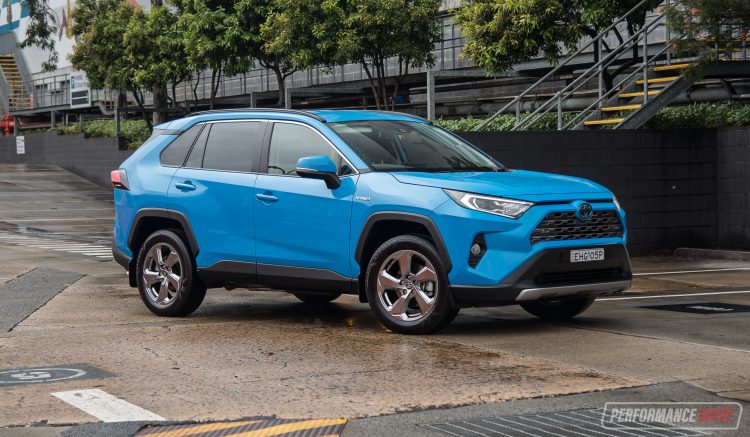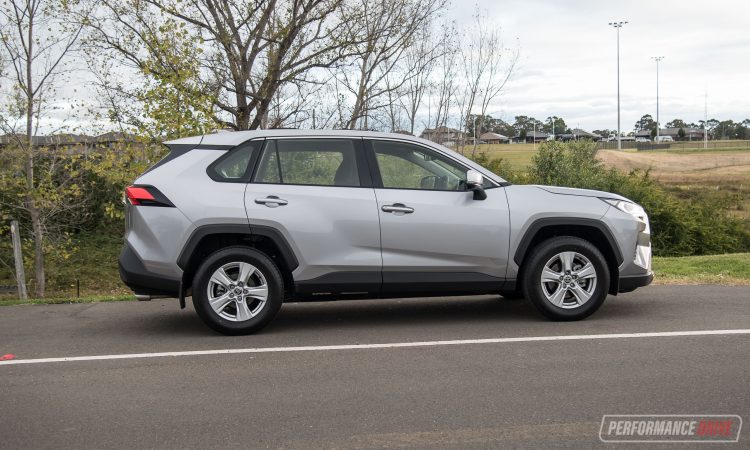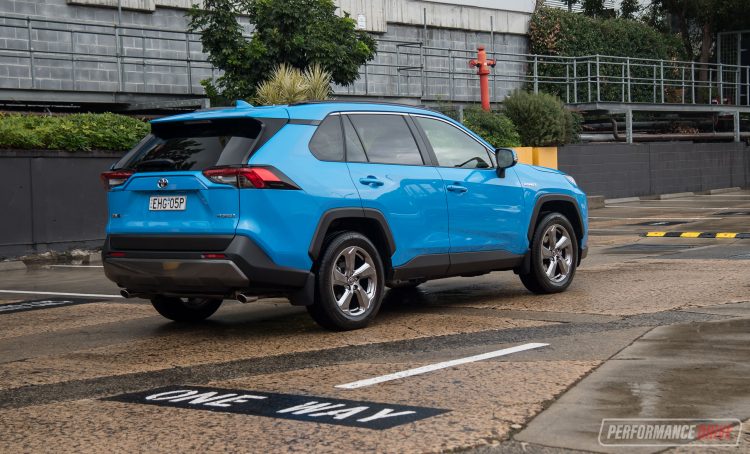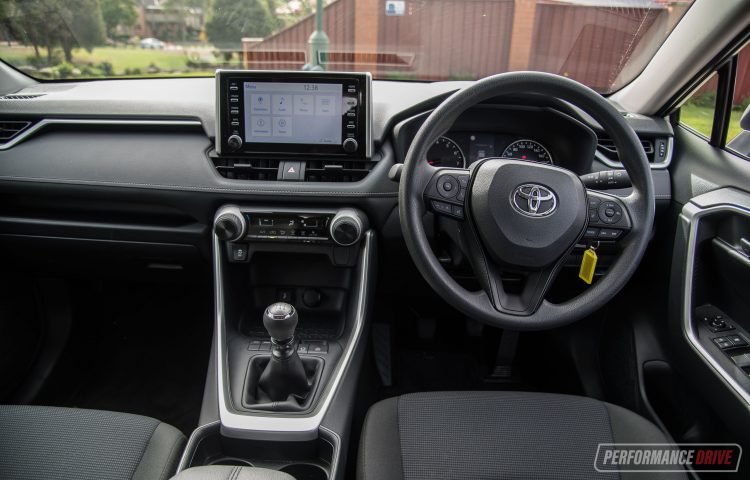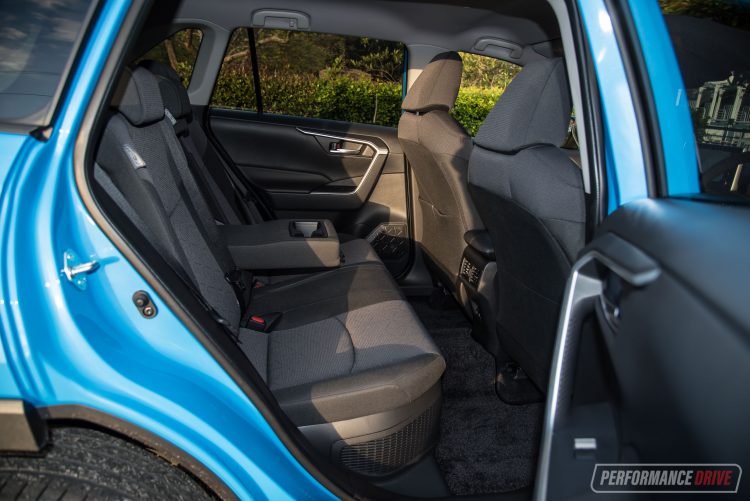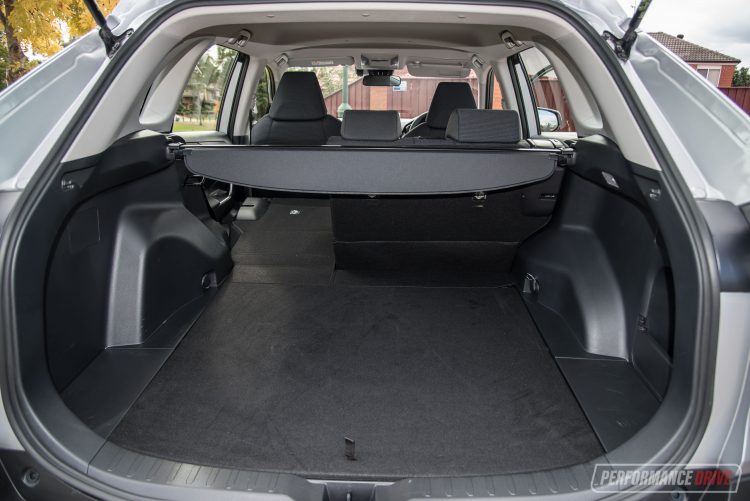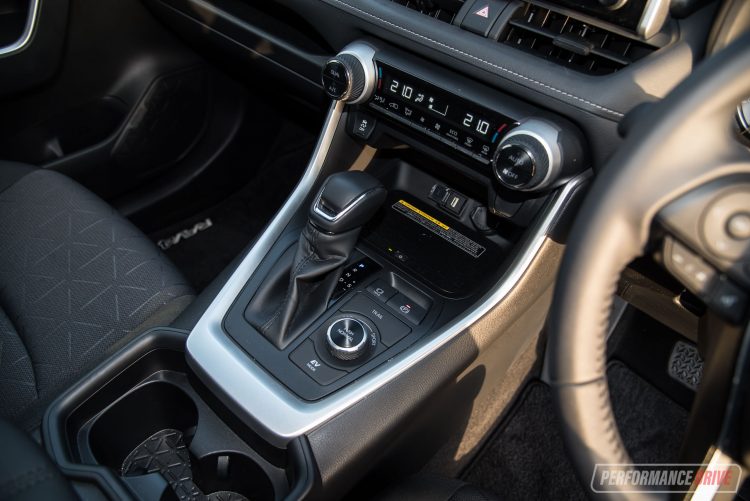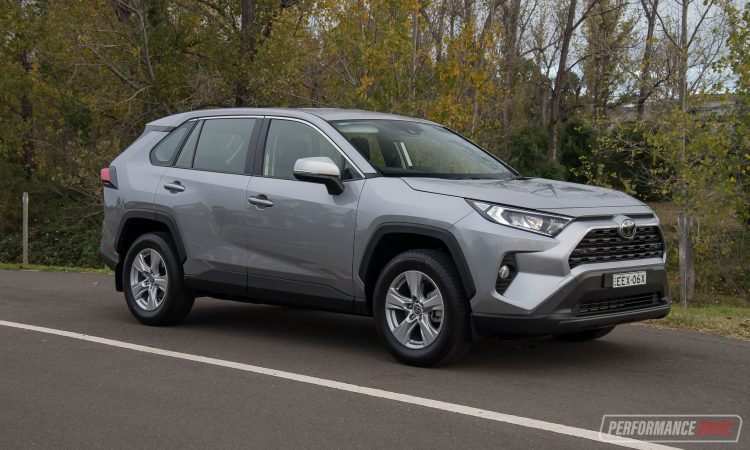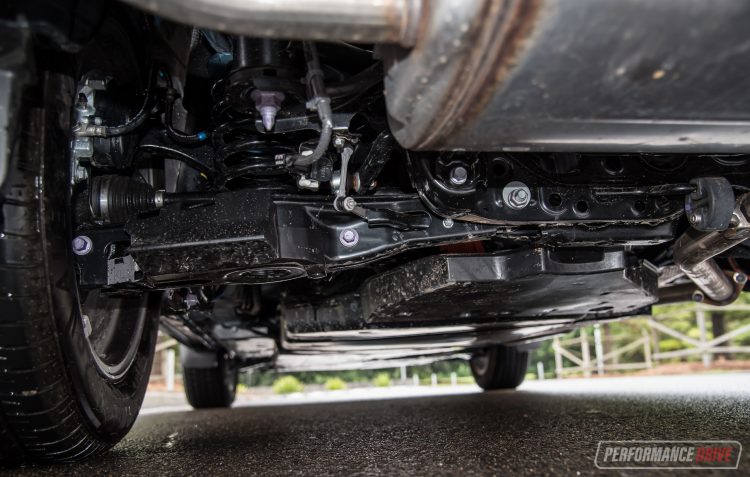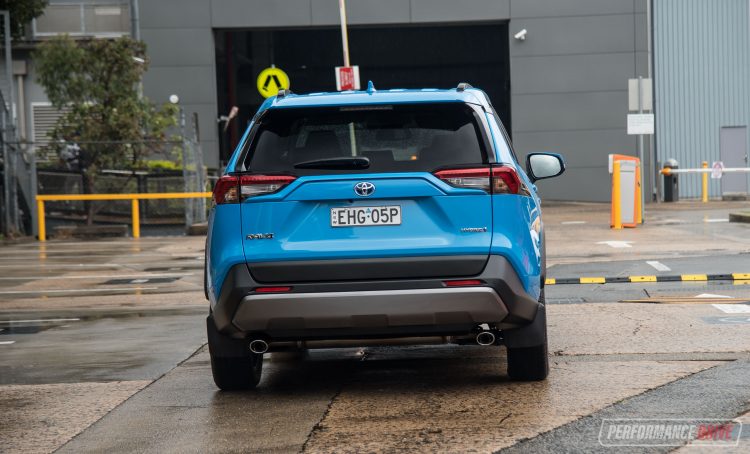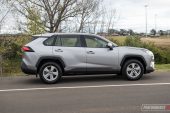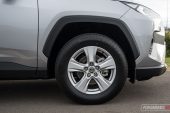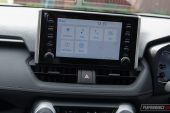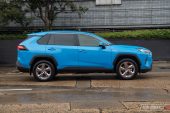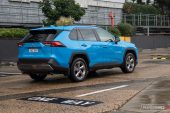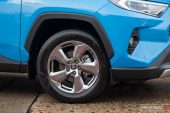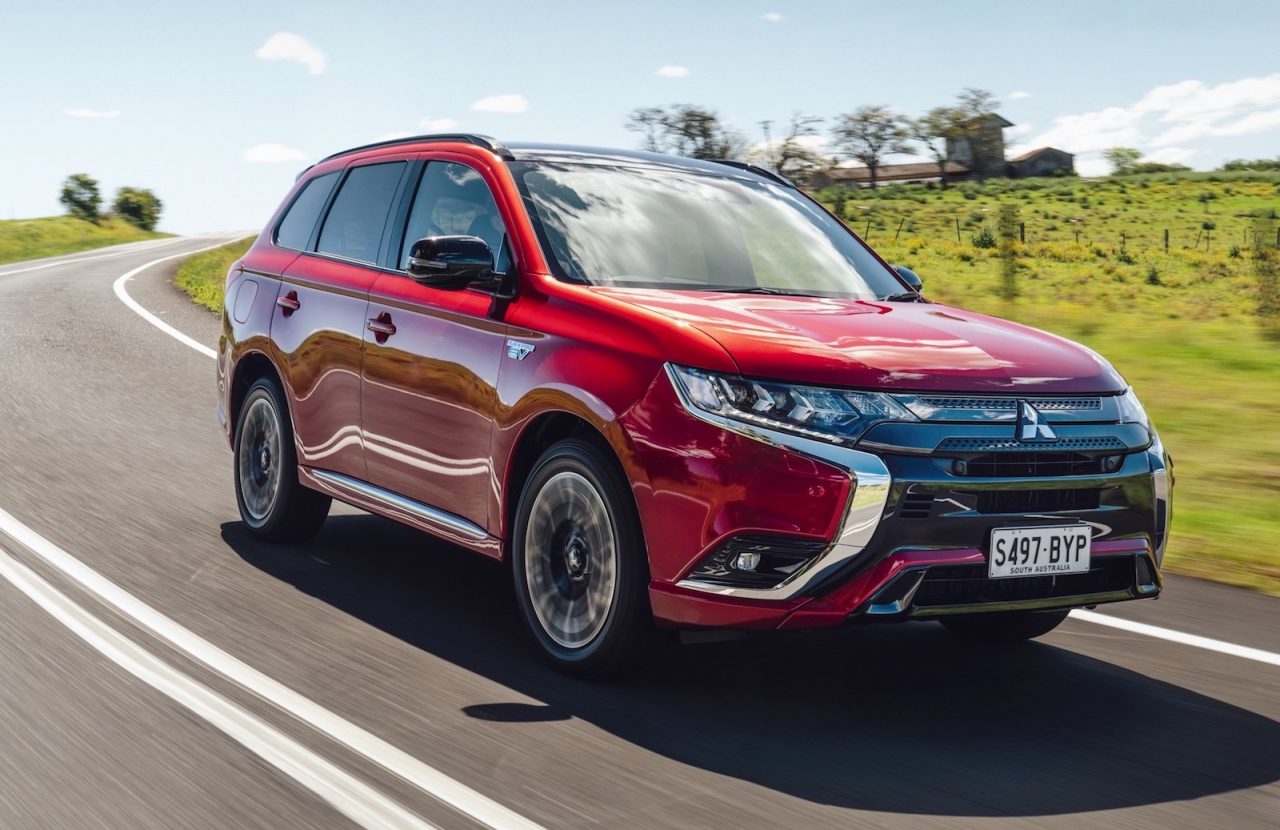The ever-popular Toyota RAV4 would have to be one of the biggest trendsetters in what has become the most popular car market today – the medium SUV. Starting out in the ’90s as a smaller SUV in two-door form, it has now grown into a bigger, more striking and powerful mid-sizer that is killing it in sales.
In fact, the addition of a hybrid petrol-electric setup in the latest-gen has caused long waiting lists for buyers. Thankfully, Toyota Australia confirmed that it has secured an additional 8000 hybrid units from global supply to be delivered to our shores from July 2020.
It makes sense why the RAV4 is so popular when you look at the huge range of variants on offer. There’s the GX, GXL, Cruiser, and Edge. There are also three engines, and two-wheel drive and four-wheel drive options depending on which variant you opt for. You can even choose a manual gearbox in the base model GX. Here, we are testing the entry and middle of the spectrum. The base-model GX in manual and petrol form, and the GXL auto using the AWD hybrid setup. There’s lots on offer here, in terms of features, space, economy, power and design.
Prices begin at $32,290 for the GX manual and rise to $48,790 (plus on-road costs) for the range-topping Edge. The hybrid GXL AWD starts from $42,915, and is likely going to be the best all-rounder.
2020 Toyota RAV4 GX – THE SPECS
[column width=”47%” padding=”6%”]Engine: 2.0-litre four-cylinder
Output: 127kW@6600rpm / 203Nm@4400-4900rpm
Transmission: Six-speed manual
Drive type: Front-wheel drive
Wheels: F & R: 17×7.0, 225/65
ANCAP: Five stars
Tare weight: 1480kg
Power-to-weight: 11.65:1 (kg:kW)
Official fuel economy: 6.8L/100km
Economy during test: 7.1L/100km
Fuel capacity/Type: 55L/91 RON[/column] [column width=”47%” padding=”0″]Power efficiency: 18.67kW:L/100km
0-60km/h: 4.52 seconds*
0-100km/h: 9.31 seconds*
60-110km/h: 6.88 seconds*
1/4 mile: 17.05 seconds at 134.9km/h*
Max acceleration: 0.688g
100-0km/h braking: 3.06 seconds at 38.72 metres*
Max deceleration: -1.180g
Decibel at idle: 43*
Peak decibel at 60-100km/h: 85*
Priced from: $32,695[/column][end_columns]
2020 Toyota RAV4 GXL AWD – THE SPECS
[column width=”47%” padding=”6%”]Engine: 2.5-litre four-cylinder hybrid (three electric motors)
Output (combined): 163kW
Transmission: CVT auto
Drive type: All-wheel drive
Wheels: F & R: 18×7.0, 225/60
ANCAP: Five stars
Tare weight: 1695kg
Power-to-weight: 10.39:1 (kg:kW)
Official fuel economy: 4.8L/100km
Economy during test: 5.0L/100km
Fuel capacity/Type: 55L/91 RON[/column] [column width=”47%” padding=”0″]Power efficiency: 33.96kW:L/100km
0-60km/h: 4.15 seconds**
0-100km/h: 8.90 seconds**
60-110km/h: 6.02 seconds**
1/4 mile: 16.57 seconds at 144.5km/h**
Max acceleration: 0.822g**
100-0km/h braking: 3.09 seconds at 39.50 metres**
Max deceleration: -1.137g**
Decibel at idle: 24**
Peak decibel at 60-100km/h: 76**
Priced from: $42,915[/column][end_columns]
* Figures as tested by PerformanceDrive on the day. Factory claims may be different. ** Figures based on RAV4 Cruiser AWD Hybrid
2020 Toyota RAV4 GX & GXL – THE PACKAGE
Recent Toyotas have made desperately needed headways in modern exterior design. The fifth-generation RAV4 exhibits this trend brilliantly. Gone are the days of plain, boxy-looking RAV4s. The exterior gives off a totally reinvented SUV vibe with rugged contours, angular shapes and aggressively styled lights from front to rear. There are plastic lower bumpers on the GX to give off that rugged appeal. We love its overall proportions, yet it still looks like an SUV/high-riding wagon made for Aussie adventures.
Describing the interior is unalike describing the exterior. It adopts a more conservative and hardwearing design, especially in GX form. For example, the large round rubber knobs to control the air conditioning could be received as strong and rugged, but unsophisticated. There is not a lot of pizzazz going on inside, but it is wonderfully practical, spacious and easy to navigate. With so many storage holes and wriggle room, we found ourselves appreciating that more than the slight lack of style.
There is an applaudable amount of rear leg and head room too. Every row is well-accommodated with air vents, big bottle holders in the doors, and four fast charging USB power ports with a wireless phone charger for GXL models and above.
Both of our GX and GXL had comfy and soft cloth seats in the front and rear rows, with basic adjustments. Only models above these score leather and electric adjustment in the front. As expected, it’s delightfully effortless to get in and out of thanks to the height of the SUV and the lack of side bolstering on the seats to hobble in and out of. There is a notable airiness to the cabin too, thanks to bigger windows and one of the best designs to prioritise outside vision.
Where we’d love to see an improvement is with the range-wide 8.0-inch centre touch-screen, and the 4.2-inch multi-info display in the instrument cluster for the GX and GXL. The layouts feel all too common and outdated nowadays, and the resolution blasts us back in time a few years. Late 2019 saw Android Auto and Apple CarPlay come as standard on all models, which helps improve the theme of the centre screen when connected.
Boot space has been lengthened over the previous generation by 65mm to a huge 1015mm. This makes the volume one of biggest in this market, measuring at 580 litres. That’s a lot bigger than the Mazda CX-5 (442L) and Subaru Forester (498L).
All RAV4s are granted with a pre-collision safety system (AEB) with day/night pedestrian and day cyclist detection, active cruise control, lane and steering assist, speed sign recognition, auto high beam, blind-spot monitor, rear cross-traffic alert, front and rear parking sensors, and a rear-view camera.
Step into the GXL and you gain roof rails, bigger 18-inch alloys (up from 17s), a leather steering wheel and gear lever, auto-dimming rear-view mirror, a wireless phone charger, and keyless entry and start. We think the GXL is the perfectly fitting model for this class, offering the best bang for your buck. You get a good balance of the latest tech and at the right price.
Even though Toyota is one of the best in the business for servicing costs and reliability, recent years have seen huge improvements in the warranty period. All Toyotas now come with a five-year, unlimited kilometre warranty. Servicing is required every 15,000km or 12 months, and capped price servicing is offered.
2020 Toyota RAV4 GX & GXL – THE DRIVE
Starting with the GX in manual, we tested the thrifty 127kW naturally aspirated 2.0-litre, four-cylinder petrol engine. This power output is not too shabby for an entry-level engine. But that peak output does not come to play until way up at 6600rpm. This means that it’s quite a shrieky engine that needs to be revved before it’s fully utilised. We timed 0-100km/h in a satisfactory 9.31 seconds.
Sadly, no turbo means that only 203Nm of torque can be extracted, between a narrow 4400-4900rpm band – you need to keep the revs up on those steeper hills. To drive around town, it’s a totally liveable amount of power, and the clutch and six-speed gearbox are super-easy to operate.
And speaking of easy to operate, the manual does not lose out on any crucial safety features. It still gets the emergency braking and a nifty active cruise control that allows you to change gears without de-activating the cruise. We hadn’t seen this in any other manual car, and it works brilliantly. The moment you engage the clutch, the throttle is decreased, and letting go of the clutch resumes the throttle automatically.
Officially, the 2.0L engine burns a fair 6.8L/100km on the average cycle. Our testing was not far off that, at 7.1L, which is not too bad for this class. As with all RAV4 engines, it can run on 91RON rated fuel, which is one point up against some of the European rivals.
The hybrid option, as featured here in the blue GXL all-wheel drive, is well worth the extra dosh we think. It’s a double-edged sword with more power and better economy. It is made up of a 2.5-litre, four-cylinder naturally aspirated petrol engine and two AC synchronous permanent magnet motors that are powered by a 6.5Ah nickel metal hydride battery, powering the front wheels.
There is also a third motor generator to power the rear wheels. It can deliver up to 80 percent of the available torque to the rear wheels. This setup provides a combined power output of 163kW, and we timed 8.90 (in the Cruise variant – we also ran 8.16 in a quick stand-alone test on this GXL). No need to fuss around with charging. It recharges itself during braking and using the petrol engine.
On the road, the hybrid feels much more competent in tackling steep hills and zipping up to speed quickly. You can select drive modes for all environments; Eco, Normal, Sport, EV (full electric) mode, and an additional Trail mode. In off-road environments, Toyota explains that Trail mode applies braking force to a slipping or freely-rotating wheel, enabling the drive torque to be automatically directed to the grounded wheels or those with the most traction.
Where the hybrid all-wheel drive really nails it is in fuel economy. Officially, it sips only 4.8L/100km. Even with our harsher testing, we averaged a miserly 5.0L/100km. Like with most hybrids, the greatest savings in fuel are made when you are undertaking slower city-style driving. Highway speeds will see the consumption rise closer to the averages seen in the 2.0-litre petrol engine.
Those who have driven the previous generation RAV4 will notice an enhanced driving experience with more energetic handling and improved ride comfort, both on and off road. The Toyota New Global Architecture (TNGA) sees better weight distribution and straight-line drive stability. There are MacPherson struts up front and multilink suspension with a stabiliser bar at the rear. Thanks to repositioning of dampers and trailing arms, you can appreciate excellent shock absorption and ride comfort. It’s all very compliant and refined.
Off road, the RAV4 has plenty of suspension travel to negotiate mild mounds and dips. It’s good to see selectable drive modes to help handle something other than tar. We didn’t venture too far off the tar, but we felt less like we were going to break something than some other SUVs in this market. The RAV4 in all-wheel drive form also claws across slippery surfaces well. We put the system to the test on a wet grassy hill and it pulled straight up.
2020 Toyota RAV4 – THE VIDEOS
2020 Toyota RAV4 GX & GXL – THE VERDICT
It’s been a giant leap for the Toyota RAV4 in its latest form. We have no doubt that it will continue to spearhead the competition with its more youthful, yet more practical design. Buyers are spoilt for choice with a vast range of grades and engines to cater for most budgets. We especially love the minuscule fuel consumption of the new hybrid, and without a sacrifice in performance.
Toyota is also suddenly generous with its standard features, so there’s less need to spend big on expensive brands. The company’s biggest problem will be to keep up with the strong demand Down Under.
[column width=”47%” padding=”6%”]PROS:
– Class-leading cabin and boot space
– Many important features standard across the range
– Brilliant all-round vision from driver’s seat
– New IMT (intelligent manual transmission) works well
– Excellent real-world fuel economy in hybrid
[/column] [column width=”47%” padding=”0″]CONS:
– 2.0L needs to be revved high, sluggish low down
– Basic touch-screen graphics and functionality
– Space-saver spare, full-size option only for GX[/column][end_columns]
As always, if you’re thinking about buying a new car don’t forget to click here to speak with our car buying specialists.
